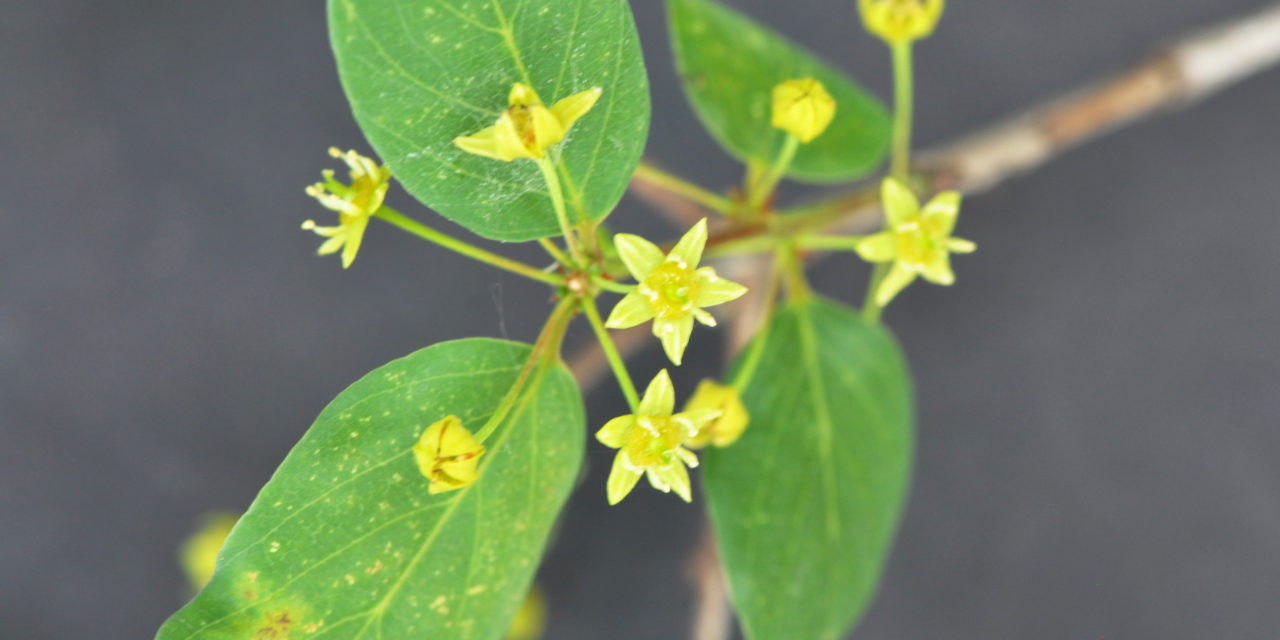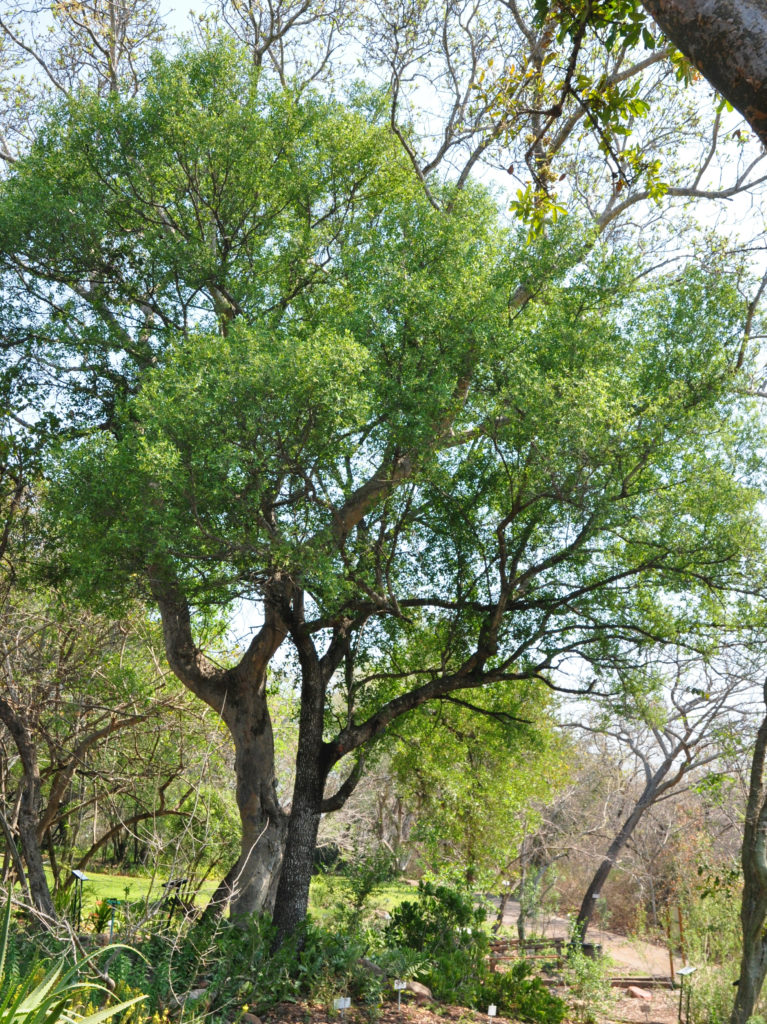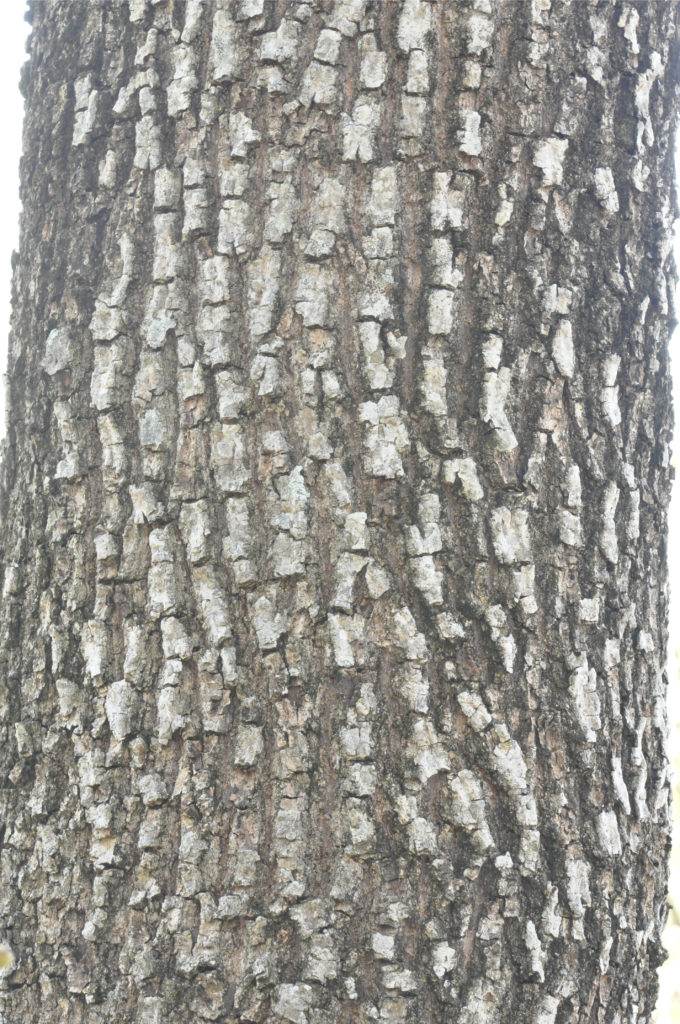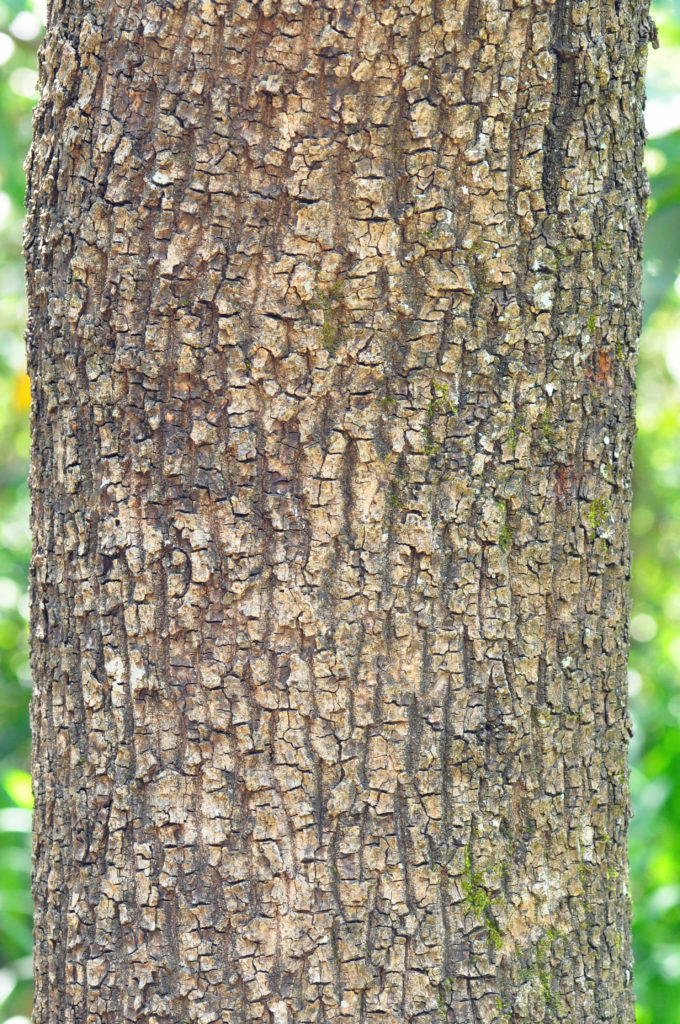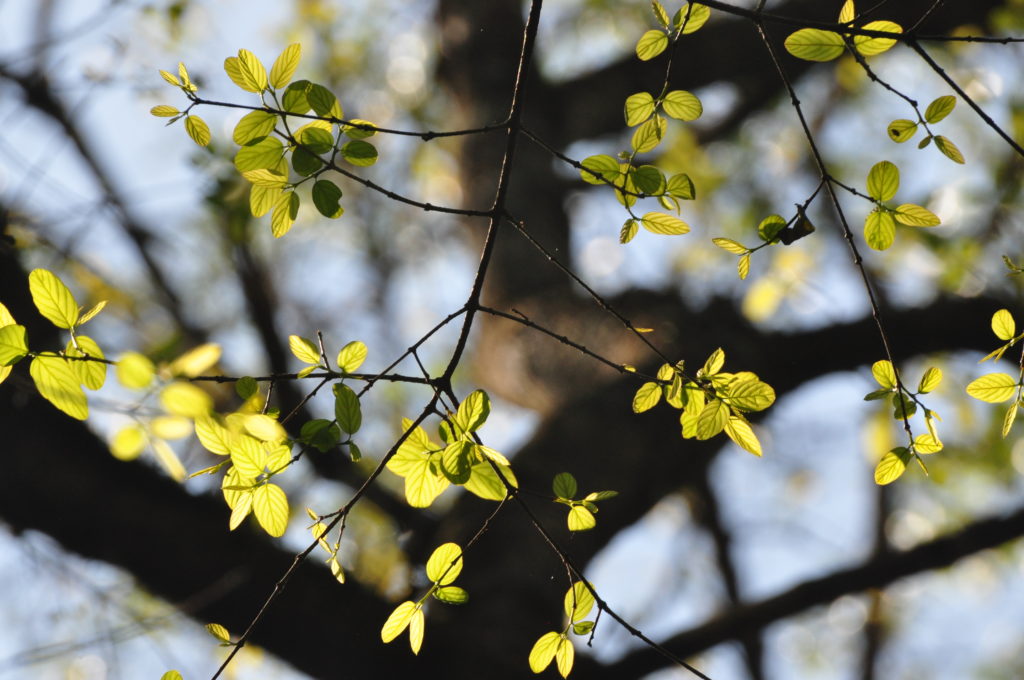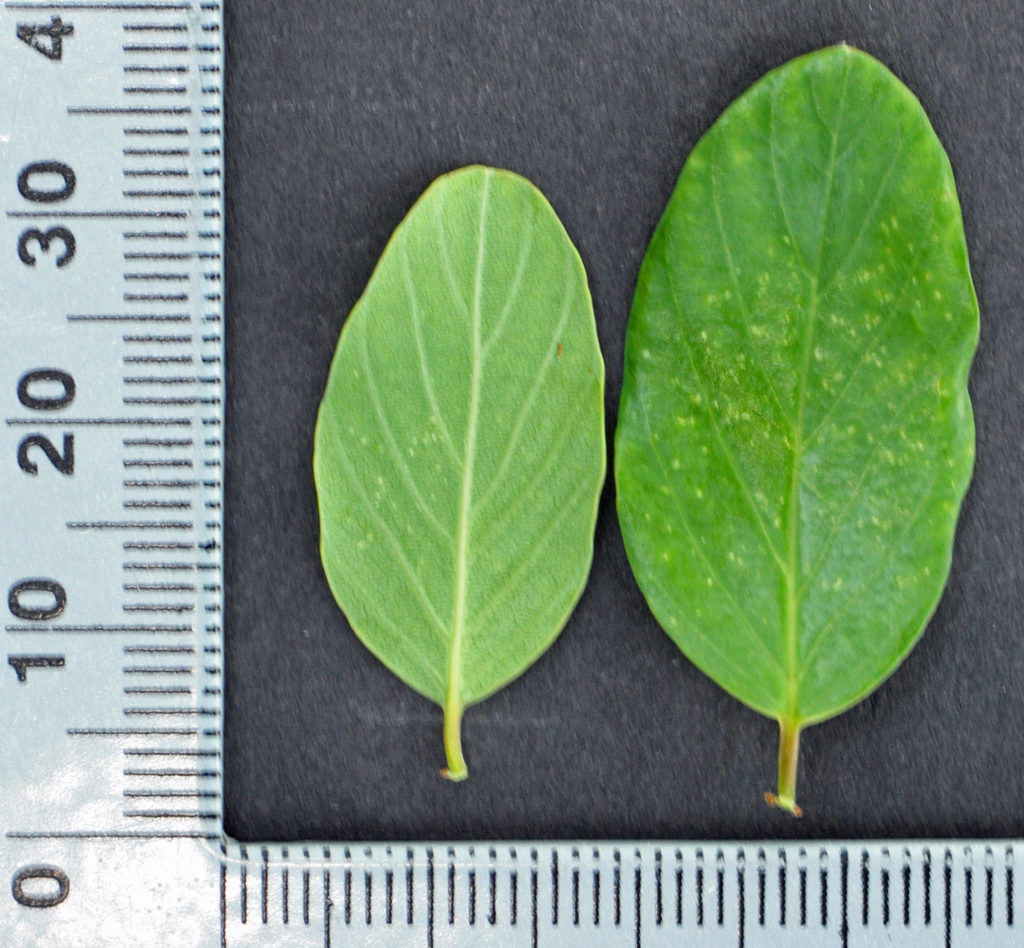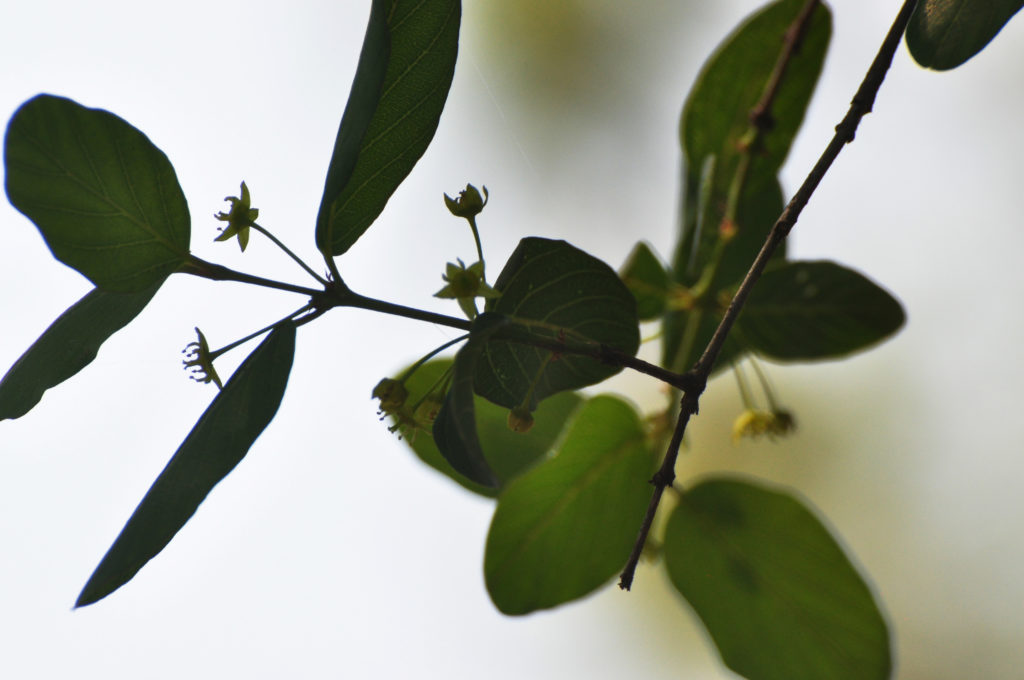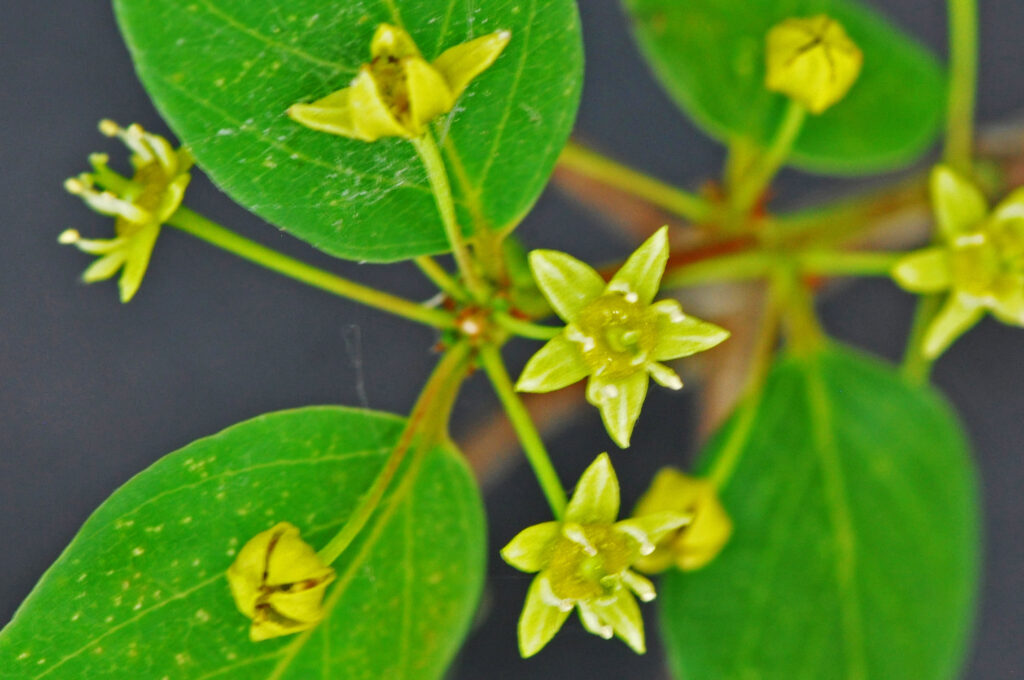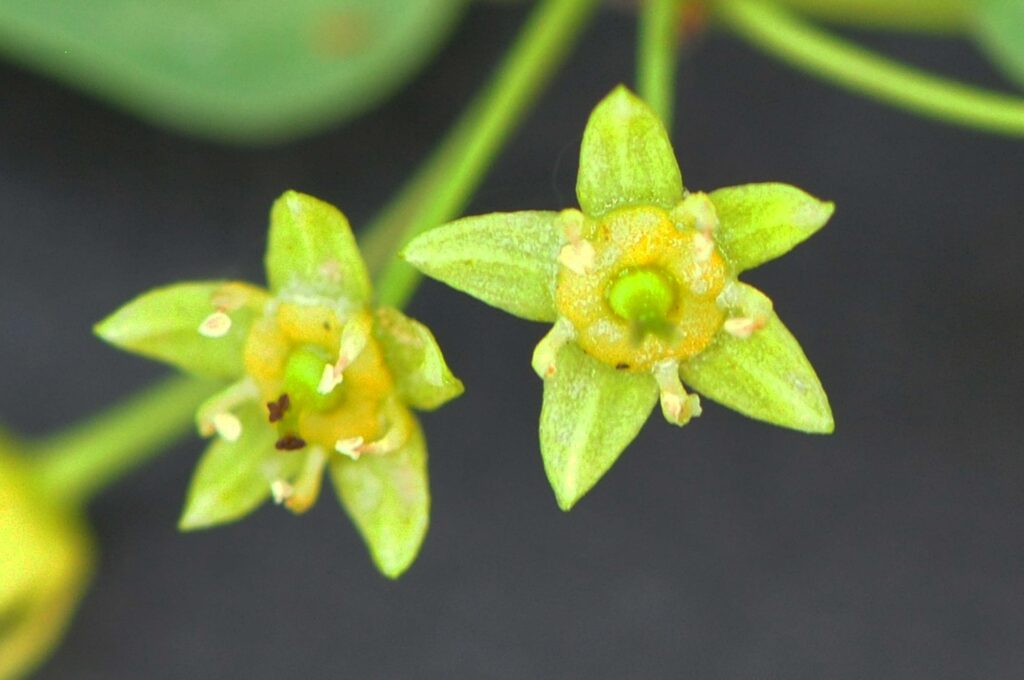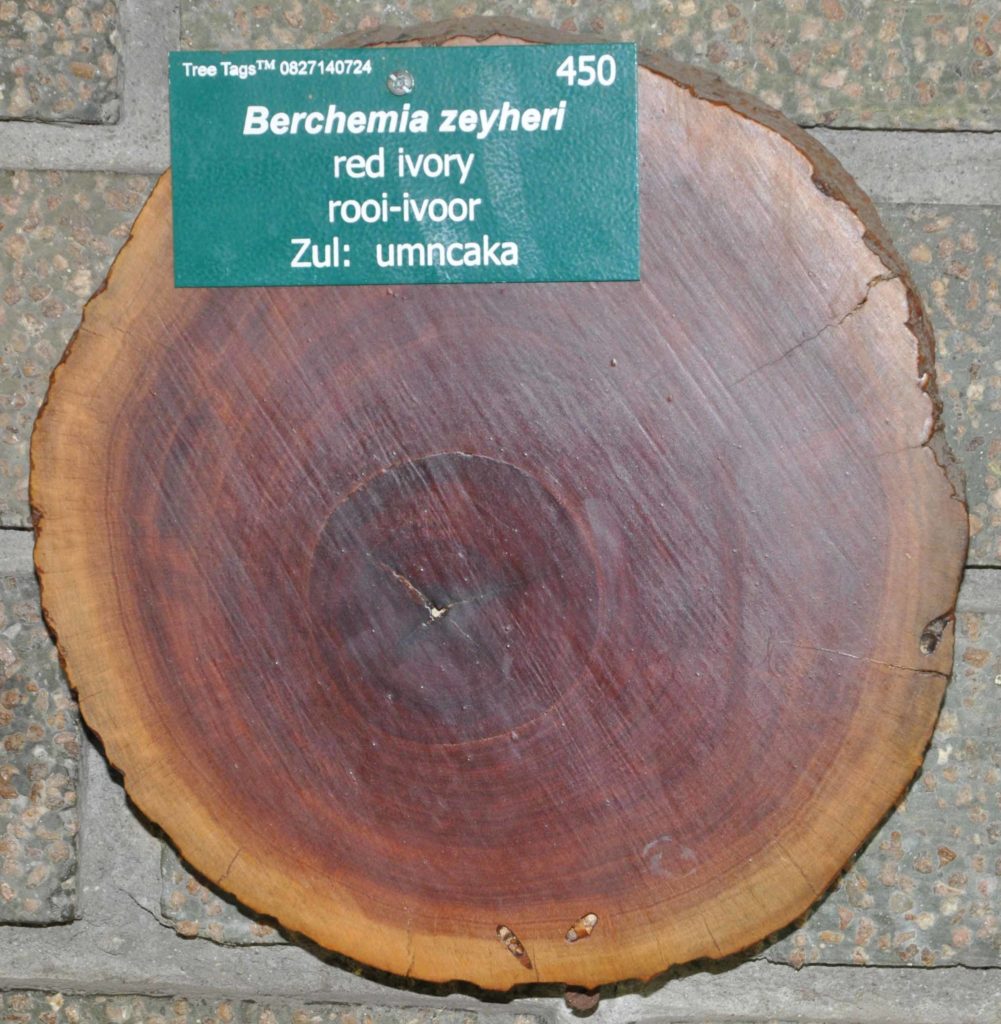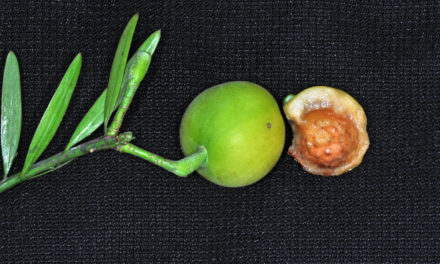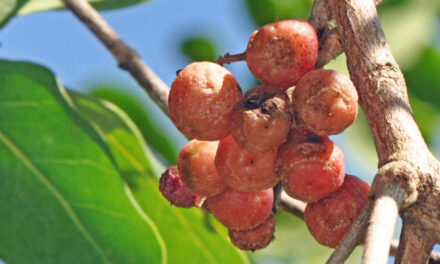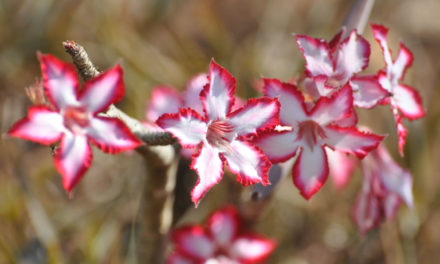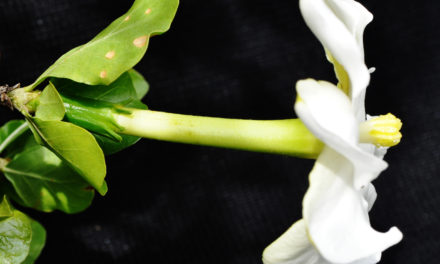Berchemia zeyheri
N.B. Phyllogeiton zeyheri is an acceptable synonym for Berchemia zeyheri.
See Berchemia zeyheri | Plants of the World Online | Kew Science
General Info – summary
This deciduous Tree is up to 12m high with a rounded crown and a trunk up to 36cm wide. The small simple, Leaves are thin & side veins reach margins. Each bisexual, regular, 5-merous Flower rest on a long pedicel, has yellowish-green sepals, short petals & 5 stamens. The single, superior ovary is 2-locular & and each locule has 1 ovule. Fruit: a small, smooth, indehiscent, edible drupe, partly enclosed in the calyx.
Previous Names: Berchemia transvaalensis, Rhamnus zeyheri.
SA Tree No. 450.
Common names: (Afr) Rooihout, Rooi-ivoor. (Eng) Pink Ivory, Purple Ivory, Red Ivory, red ivorywood. (IsiNdebele) Mnaga, Umcaga, Umnyii. (isiXhosa) Umnini. (isiZulu) Umgologolo, Umncaka, Umneyi, Umnini. (Northern Sotho) Monee. (Setswana) Moye. (siSwati) Umneyi, Sineyi. (Tshivenda) Muhukhuma, Muniaiane, Muniane, Munia-niane. (Xitsonga) Nyilyani, Nyiyani, Umnini, Xiniyani,
Family: Rhamnaceae. (Buckthorn Family). This family mainly contains trees and shrubs. It has about 58 genera and 900 species. In South Africa, there are 9 genera and 203 species. Trees on this website include Berchemia, Noltea, Rhamnus and Ziziphus. Leaves are simple and usually alternate, and stipules are present – if only for a short time. Flowers are actinomorphic (regular and symmetric) and a prominent hypanthium (the cup-like receptacle usually derived from the fusion of floral envelopes and androecium, and on which are seemly borne calyx, corolla and stamens) is present. Sepals are well developed and Petals are free and in 4’s or 5’s. The Calyx is tubular, and sepals do not overlap. The free petals arise from the calyx tube or from the outer margin of the disc. The 4-5 Stamens arise with, and opposite the petals. Anthers have up to 2 pollen sacs and pollen is released through longitudinal slits. The Ovary is usually superior and has 2-5 chambers. Fruit is a drupe, which is partly enclosed by a persistent Calyx. Most members have adapted to dry climates.
Name derivation: Phyllogeiton named after M Berchem, a French botanist in the 17th century. zeyhrai named after Carl L. P. Zeyher: noted German botanist for his fundamental work on Flora Capensis (a systematic description of the Plants of the Cape colony and neighbouring territories). There are 2 species of the genus Berchemia in southern Africa. The other is Berchemia discolor.
Conservation: National Status: L C. (Least Concern). Assessed: 2005/06/30 (W. Foden and L. Potter). The good wood quality may pose a problem in the future due to illegal harvesting.
Tree
This unarmed Tree may be small and bushy or may reach 12-15m high. The Trunk is usually straight with a diameter up to 36cm, ending in a rounded, leafy crown (photo 933). Young branches have smooth bark that may become a reddish purple. The Bark is initially smooth and grey to light brown. Older trees have bark that is darker and cracked into longitudinally running segments, which may appear rectangular (Photos 931 & 635).
This unarmed Tree may be small and bushy or may reach 12-15m high. The Trunk is usually straight with a diameter up to 36cm, ending in a rounded, leafy crown (photo 933). Young branches have smooth bark that may become a reddish purple. The Bark is initially smooth and grey to light brown. Older trees have bark that is darker and cracked into longitudinally running segments, which may appear rectangular (Photos 931 & 635).
- 933. 2014/09/15. Lowveld NBG. Photo: David Becking.
- 931. 2014/09/14. Lowveld NBG. Photo: David Becking.
- 635. 2014/09/14. Lowveld NBG. Photo: David Becking.
Leaves
This attractive, usually deciduous tree, has delicate, smooth Leaves (photo 943) that are opposite or nearly so (photo 934 – under Flowers). In winter they may turn a clear golden colour. Leaves are simple (have a single blade, which may have incisions that are not deep enough to divide the blade into leaflets) and are a similar shape but smaller than those of Berchemia/Phyllogeiton discolor. The Margin is often entire (with a continuous margin, not in any way indented) but may appear to be scalloped between the side veins that go directly to the margin forming a herringbone pattern. The Midrib (the main rib of a leaf or leaf-like part, a continuation of, but excludes the petiole) and other veins and are more visible below (photo 943). In colder areas, the leaves may turn yellow or a clear golden colour before falling. They are elliptic to ovate and up to 50 x 35mm. The shiny Blade may be slightly hairy. Young leaves are thin and initially bright green (photo 636), maturing to dark green, blue-green or grey green above and slightly lighter below (photo 943). The Apex is rounded or broadly pointed and may be notched. The Base may be reddish and is round, narrowed or cordate (heart-shaped). The Petiole (leaf stalk) is slender, short – up to 5mm long, may be reddish purple, and is slightly twisted. The upper surface of the petiole is channelled (photo 943).
- 636. 2014/09/14. Lowveld NBG. Photo: David Becking.
- 943. 2014/09/14. Lowveld NBG. Photo: David Becking.
Flowers
The inconspicuous bisexual, pale yellowish green, 5-merous (having a specific number of parts – in this case 5) Flowers are small (up to 16mm long and 4mm in diameter). They occur in small axillary (in the axil. growing between stem and leaf) clusters (photo 934) and supported by long, thin Pedicles (individual flower stalks) that are usually up to 18mm long (photo 939). Flowers are actinomorphic (Regular, symmetrical. Flowers are vertically divisible into similar halves by more than one plane passing through the axis). Each flower has 5 ovate, non-overlapping Sepals with a keel on the inner face (photo 937). Petals are orange and much shorter than the sepals and are clawed and spatulate (broad rounded apex and tapering rapidly to the base). The Disc (more or less fleshy or elevated development of the receptacle) is swollen. The 5 Stamens are as long as the sepals, arise between the sepals and are inserted outside the disc (photo 939). The Anthers open through longitudinal slits. Flowers have a single Pistil (a unit of the Gynoecium, the female element of the flower, composed of the ovary, style and stigma) containing a superior (said of an ovary that is free from the calyx or perianth) 2-locular Ovary that is immersed in the disc. A solitary basal Ovule is contained in each locule. The conical, relatively thick Style (photo 937) is 2-lobed. The Stigma is gland bearing. (Aug-Jan).
- 934. 2014/09/15. Lowveld NBG. Photo: David Becking.
- 939. 2014/09/15. Lowveld NBG. Photo: David Becking.
- 937. 2014/09/15. Lowveld NBG. Photo: David Becking.
Fruit
The small (up to 14 x 5mm), smooth, fleshy oval, ovate (shape of an egg with the widest point closest to the pedicel) or ellipsoidal Fruit is a Drupe (a fleshy, 1-seeded indehiscent fruit) with the seed enclosed in a stony Endocarp (the fruit wall), like a very small peach pip. The Mesocarp (the middle layer of the drupe) is the thinly fleshy edible part. The outer layer is the Exocarp (the thin skin). Each drupe is attached to the stem by the now older, long thin Pedicel (the original single flower stalk). The initially green fruit turns yellow or reddish brown when mature and resembles a very small peach fruit – on which the remains of flower style may still be visible. (Dec-May).
Distribution & Ecology
The Tree is Endemic in southern Africa. (Endemism is the ecological state of a species being unique to a defined geographic location). These trees are common in KwaZulu-Natal, Mpumalanga e.g., near Middelburg, Gauteng e.g., Hartbeespoort Dam – close to Pretoria, Limpopo and North West. Beyond South Africa, they occur in Botswana, Zimbabwe, SiSwati (Swaziland) and southern Mozambique. They often occur in dense groups with other trees. Galls (in plants are abnormal outgrowths of plant tissue caused by parasites like fungi, bacteria mites and insects seeking nutrition) may develop on branches. This Tree is located at low to medium altitudes in the bushveld (a sub-tropical woodland ecoregion of southern Africa), rocky hillsides, stony ridges, bushy stream banks, dry forests and near old termite mounds. In these areas the trees are common on south and east-facing slopes. This tree is drought resistant but sensitive to frost. Illegal tree harvesting is a problem. The Flowers attract a lot of bees and other insects. The Leaves are heavily grazed by herbivores. Baboons, monkeys and bush babies (nocturnal monkeys, Afr: nagapies) eat the Fruit. Birds including barbets, loeries (turacos), doves, bulbuls, starlings and Green Pigeons, and other animals also eat the fruit. Impala and Nyala eat both the fruit and leaves. Porcupines eat the Bark.
Ethnobotany
The sweet, sticky Fruit is edible, good tasting and much sought after by both people and animals. Dried fruit may be stored for future use. In the process, it becomes a brown sugary mass and makes a concentrated ration for a long journey. Sun dried fruits are stamped together and mixed with porridge. Local people sell the fruit. The sought after, lovely bright red or pink, very hard, dense (very close to that of water), fine-grained Hartwood has a fine texture, turns and polishes well. The sapwood is pale cream, and the heartwood is an attractive pinkish red (photo 179). Uses include the manufacture of quality furniture, ornaments, fence poles, knife handles, knobkerries, sticks and bows. This Wood known for being resistant to insect attack but is difficult to plane and takes a long time to air-dry. Wood is used for quality timber. At one time only chiefs in KwaZulu-Natal were allowed to carry a knobkerrie made from this tree. A purplish dye is extractable from the Bark. Propagation is easily carried out using cleaned seeds. This is a good bird, bee and butterfly tree. Local medicine makes use of various tree parts.
- 179. 2019/08/13. Skukuza KNP. Photo: David Becking.
References
Boon, R. 2010. Pooley’s Trees of eastern South Africa. Flora and Fauna Publications Trust, Durban.
Burrows, J.E., Burrows, S.M., Lotter, M.C. & Schmidt, E. 2018. Trees and Shrubs Mozambique. Publishing Print Matters (Pty) Ltd. Noordhoek, Cape Town.
Coates Palgrave, M. 2002. Keith Coates Palgrave Trees of Southern Africa, edn 3. Struik, Cape Town.
Foden, W. & Potter, L. 2005. Berchemia zeyheri (Sond.) Grubov. National Assessment: Red List of South African Plants version . Accessed on 2025/02/12.
Lawrence, G. H. M, 1951. Taxonomy of Vascular Plants. The Macmillan Company, New York. Tenth Printing 1965.
Palmer, E. & Pitman, N. 1972. Trees of southern Africa. Balkema, Amsterdam, Cape Town.
Schmidt, S. Lotter, M. & McCleland, W. 2002. Trees and Shrubs of Mpumalanga and the Kruger National Park. Jacana, Johannesburg.
van Wyk, B. & van Wyk, P. 1997 Field guide to Trees of Southern Africa. Struik, Cape Town.
Galls. From Wikipedia, the free encyclopedia
http://www.plantzafrica.com/plantab/berchemzey.htm
https://en.wikipedia.org/wiki/Pink_ivory
http://pza.sanbi.org/berchemia-zeyheri
http://posa.sanbi.org/flora/browse.php?src=SP

